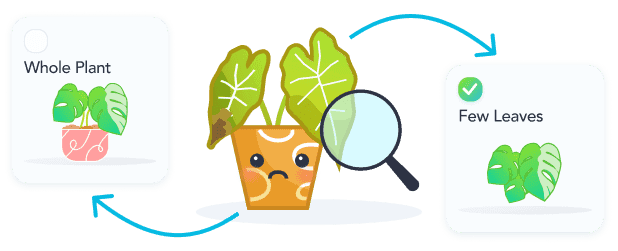Every 7d
Recommended Frequency
1 /2 cup of water
Recommended Amount
Lemon Surprise Dracaena prefer moist but not soggy soil. Allow the top one to two inches of soil to dry between waterings. If you notice your plant's leaves starting to brown, you need to adjust your watering schedule.
Every 30d
Recommended Frequency
Fertilize your Lemon Surprise Dracaena once a month during the Spring and Summer with a slow release fertilizer.
Indirect Sun
Recommended
Indirect Sun or Filtered Sun is when sun exposure is being filtered through a sheer curtain or is not able to have the sun's rays directly hit the leaves/flowers of your plant.
Every 730d
Recommended Frequency
Repot your Lemon Surprise Dracaena every two years, or once it outgrows its pot.
Peat Soil
Recommended Soil
Peat Soil is an acidic soil that retains a lot of moisture and slows decomposition. Due to such a high moisture retention this mix may require irrigation to help with draining. This soil type is best used when paired wit...

Shop Lemon Surprise Dracaena
Questions about Lemon Surprise Dracaena
The Lemon Surprise Dracaena is a vibrant, easy-to-care-for houseplant known for its striking, glossy leaves that feature a mix of green, yellow, and white colors. Its leaves have a unique, twisted form, adding an element...

Toxicity of Lemon Surprise Dracaena

Common Pests and Diseases
Root Rot
Overwatering
To address root rot in Lemon Surprise Dracaena, first, cease watering immediately and allow the soil to dry out. If the plant is severely affected, remove it from its pot, trim away any black, mushy roots, then repot in fresh, well-draining soil. Ensure the pot has adequate drainage holes. Going forward, water only when the top inch of soil feels dry to the touch, and avoid letting the pot sit in standing water.
Leaf Droop and Browning
Underwatering
To address underwatering in Lemon Surprise Dracaena, ensure a consistent watering schedule that keeps the soil slightly moist but not waterlogged. Water the plant deeply until excess water drains out, but allow the top inch of soil to dry out before the next watering. If the plant has been severely underwatered, immerse the pot in a water bath for about 10 minutes to rehydrate the soil evenly. Adjust watering frequency based on seasonal changes, watering more during active growth in spring and summer, and reducing in fall and winter.
Spider Mite Infestation
Spider mites are tiny pests that thrive in warm, dry conditions. They feed on the sap of the Lemon Surprise Dracaena, causing yellowing and stippling of leaves.
To combat spider mite infestations, increase humidity around your plant as these pests prefer dry conditions. Regularly misting the Lemon Surprise Dracaena can help. Additionally, washing the leaves with a mild soap solution or using neem oil can be effective. In severe cases, applying miticides according to the product's instructions may be necessary. Always isolate infested plants to prevent the spread to other houseplants.
Leaf Spot
Fungal or bacterial pathogens
To manage leaf spot, it's crucial to maintain a clean environment around your plant. Remove and dispose of any infected leaves to prevent the spread of the disease. Improve air circulation around the plant and ensure it's not in a too humid environment. If the infection is severe, applying a fungicide or bactericide, as appropriate, can be effective. Always follow the product's instructions for the best results. Preventive measures include avoiding overhead watering to keep the leaves dry.

Related Plants
Other Articles:
Top 10 Most Popular Roses
Mar 22, 2022
How to Care for China Roses
Mar 11, 2022
How to Care for Chinese Money Plants
May 15, 2020
How to Grow and Care for A Bird of Paradise
Apr 26, 2020
Top 10 Plants To Grow In A Terrarium
May 31, 2022
How to Grow and Care for Lucky Bamboo
Mar 29, 2022
How to Grow and Care for Corn Plants
Mar 29, 2022
How to Care for Madagascar Dragon Trees
Mar 21, 2022



